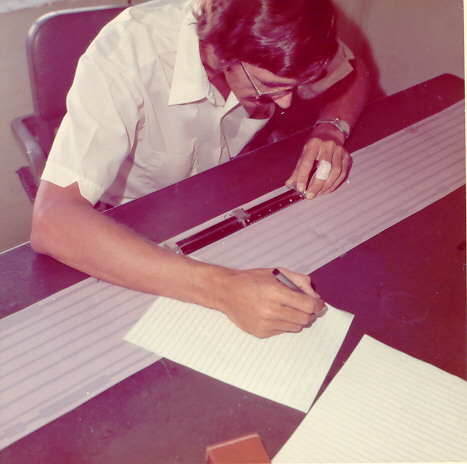Miles Mayall.
The output from several hydrophones was fed into a 7-channel Ampex tape recorder, along with a very accurate time signal from WWV. These recordings were made year round, 24/7. If anything 'interesting' appeared on the Drum Recorders (See write-up here), then the magnetic tape could be analysed further. The output from the magnetic tape was fed into an 8-channel Sanborn Paper recorder, which could spew out paper at incredibly fast and wasteful speeds, allowing for very accurate 'picking' of the exact time of the 'interesting' sound. The top line and the bottom line of the paper output received the WWV time signal, which allowed for correction of any paper skewing. There are 3 'second marks' visible on the nearest trace line (above Miles' injured finger), and quite a nice 'interesting' signal on the third trace line, for which Miles is measuring the arrival time accurately using a 'ten-point' tool, (which actually has 11 points, but we won't go there!). At the bottom left corner of the photo, the WWV time signal is producing a longer burst of activity, which marks the start on a new minute, and the characteristics of the length of the next few second marks can be decoded to give the hour and minute.
~~~~~~~~~~~~~~~~~~~~~~~~~~~~~~~~~~~~~~~~~~~~~~~~~~~~~~~~~~~~~~~~~~~~~~~~~~~~~~~~~~~~~~~~~~~~~~~~~~~~~~~~~~~~~~~~
|
(Left to Right.) Miles Mayall, Tom Graves, Peter Grayston in the Plotting Room.
|
Photo taken by Frank Watlington Jan. 1970. Courtesy of Kerry Abukhalaf (Frank Watlington's grand-daughter).
Posted June 2023 |

